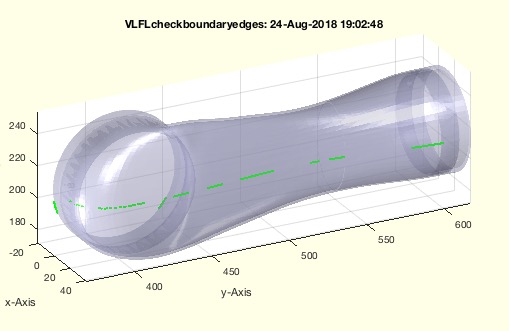SGcheckboundaryedges
by Tim C. Lueth, SG-Lib Toolbox: SolidGeometry 5.6 - Problems Find/Check/Fix
Introduced first in SolidGeometry 4.3, Creation date: 2018-08-24, Last change: 2025-09-14
returns the open boundaries of the surface
Description
This function should return the same results as the output of Meshlab from http://vcg.isti.cnr.it
more or less the same as VLFLfreeboundaryfacets
See Also: , VLFLchecknonmanifoldedges
, VLFLchecknonmanifoldvertices
, VLFLcheckboundaryedges
, VLFLcheckmeshlab
, SGchecknonmanifoldedges
, SGchecknonmanifoldvertices
, SGcheckmeshlab
Example Illustration

Syntax
[EL,CEL,fi,VL,FL]=SGcheckboundaryedges(SG)
Input Parameter
Output Parameter
EL: | | Edge list of open boundaries |
CEL: | | CEL edge list to group EL segments |
fi: | | facet index list of the facets |
VL: | | Vertex list of SG |
FL: | | Facet list of SG |
Examples
loadweb JACO_robot.mat;
SG=SGshort(JC3,1e-7); SGcheckboundaryedges(SG);
testfunctTL('SG=SGshort(JC61,#1); SGcheckboundaryedges(SG);',power(1/10,2:15))
Copyright 2018-2025 Tim C. Lueth. All rights reserved. The code is the property of Tim C. Lueth and may not be redistributed or modified without explicit written permission. This software may be used free of charge for academic research and teaching purposes only. Commercial use, redistribution, modification, or reverse engineering is strictly prohibited. Access to source code is restricted and granted only under specific agreements. For licensing inquiries or commercial use, please contact: Tim C. Lueth
Algorithm (Workflow)
The function SGcheckboundaryedges is designed to identify open boundary edges in a given solid geometry (SG). It is part of the SG-Library and was introduced in SolidGeometry 4.3. The function aims to provide results similar to those obtained from Meshlab.
Input Parameters
- SG: This is the solid geometry input, which contains the data structure representing the 3D model.
Output Results
- EL: Edge list of open boundaries. This list contains the edges that form the open boundaries of the surface.
- CEL: CEL edge list to group EL segments. This helps in organizing the segments of the edge list.
- fi: Facet index list of the facets. This list provides the indices of the facets associated with the open boundaries.
- VL: Vertex list of SG. This is the list of vertices in the solid geometry.
- FL: Facet list of SG. This is the list of facets in the solid geometry.
Algorithm Steps
- Extract the vertex list (VL) and facet list (FL) from the solid geometry (SG) using the function
VLFLofSG(SG).
- Check the number of output arguments (
nargout).
- If
nargout is 0, the function will:
- Call
dbprintf (presumably for debugging or printing purposes).
- Invoke
VLFLcheckboundaryedges(VL,FL) to check for boundary edges.
- Assign the results of
VLFLcheckboundaryedges(VL,FL) to EL, CEL, and fi.
- If
nargout is not 0, directly call VLFLcheckboundaryedges(VL,FL) and assign the results to EL, CEL, and fi.
Example Usage
The function can be used as follows:
loadweb JACO_robot.mat;
SG = SGshort(JC3, 1e-7);
SGcheckboundaryedges(SG);
This example loads a robot model, processes it with SGshort, and then checks for boundary edges using SGcheckboundaryedges.
Algorithm explaination created using ChatGPT on 2025-08-19 08:28. (Please note: No guarantee for the correctness of this explanation)
Last html export of this page out of FM database by TL: 2025-09-21